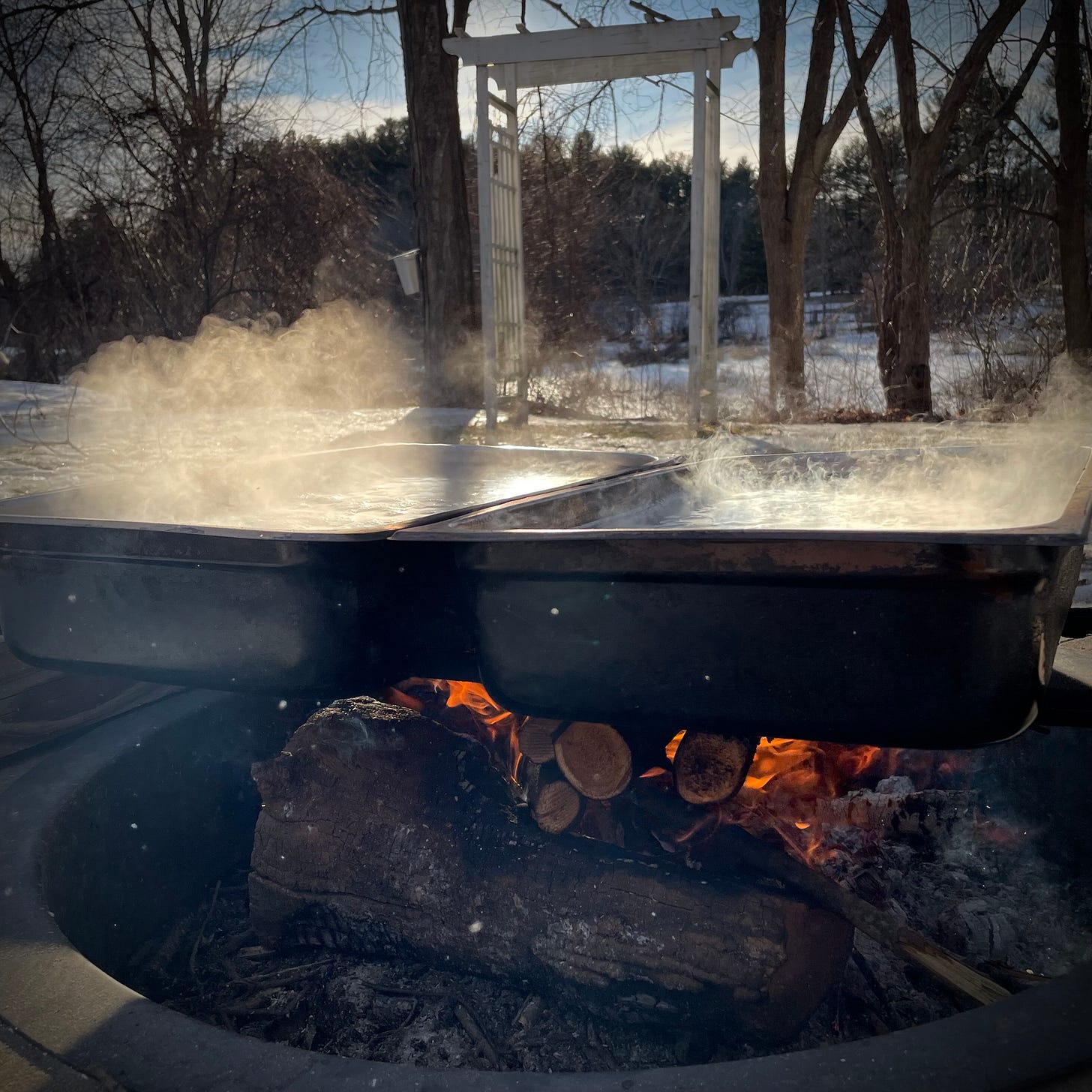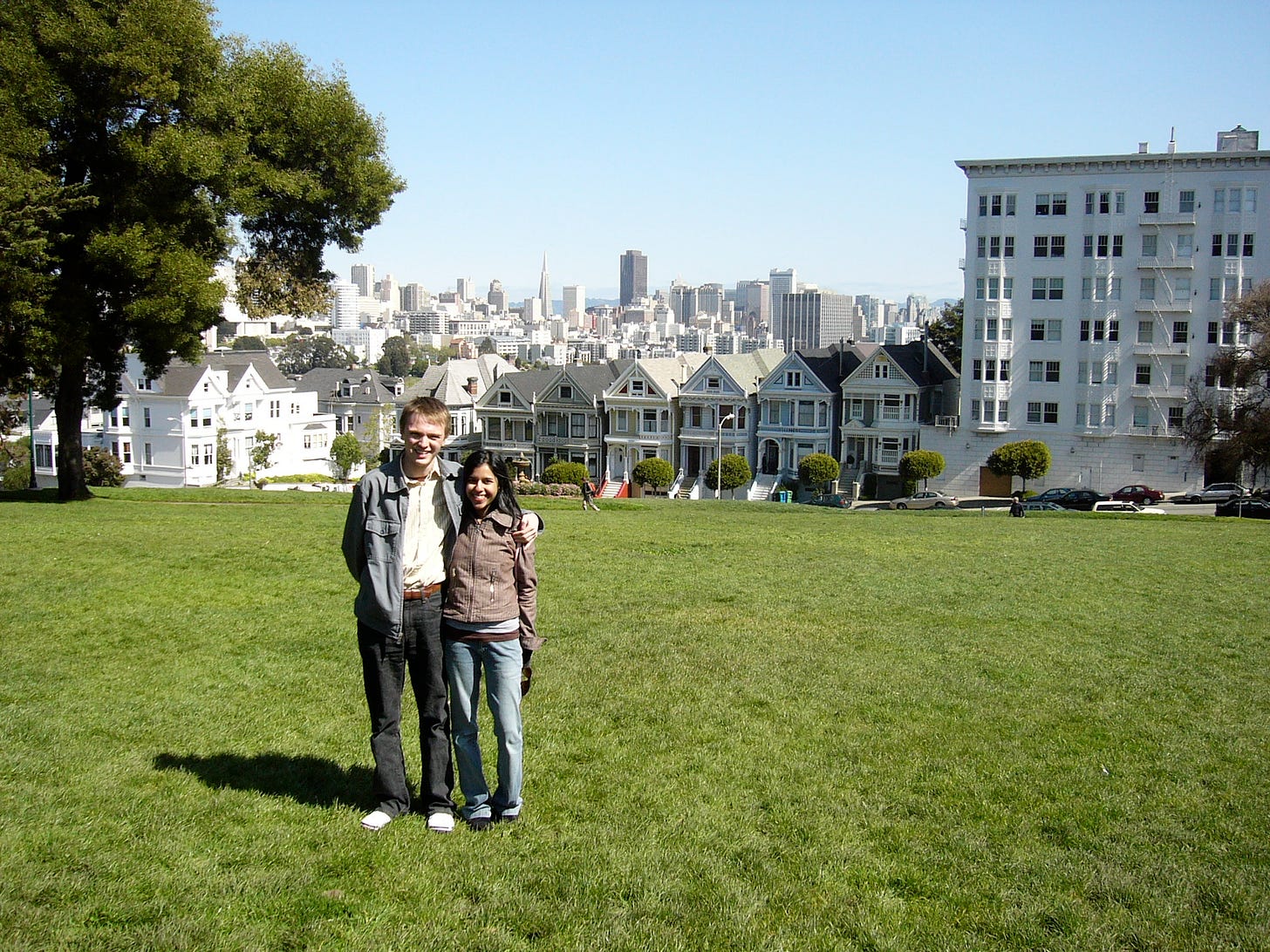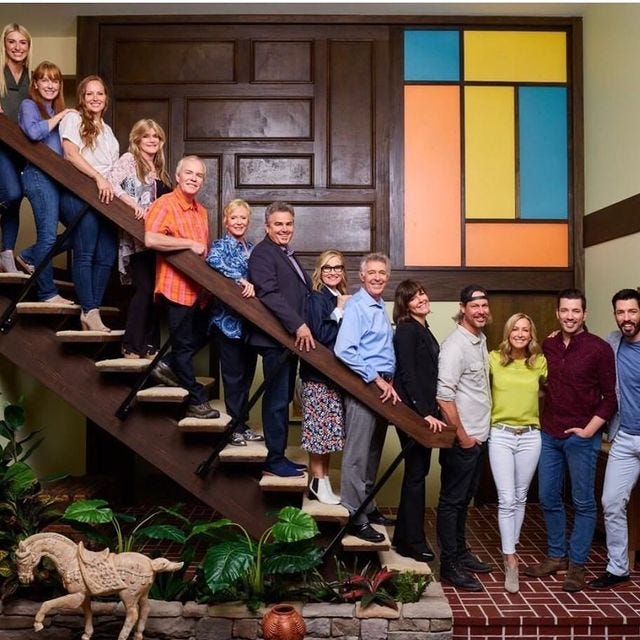Isn't That The Place From...?
Exploring why we visit movie and TV locations, our impulse to preserve them, and what's to become of a Toronto convenience store
It’s Maple Season! 🍁
Happy Sunday from Massachusetts! Things are a bit busy here as yesterday was our first maple sap boil of the season.
Tapping our maple trees and boiling the sap to make syrup has become a favorite hobby for my family since we started it last year. If you’re interested in learning more, please follow me on Instagram, where I’ve been trying to give regular updates on the process.
This week, I have an essay to share with you looking at why we place such importance on the locations we remember from movies and TV shows. Thank you for reading!
Strange Travel Habits
My wife and I recently reached an important milestone, 18 years since our first date. It’s been a nice opportunity to reminisce about old times and look back at photos from our earliest days together.
One thing I noticed about our vacations over the years was that we often made pilgrimages to locations that were familiar from TV and films. On a trip to San Francisco for example, we visited Alamo Square, whose Painted Lady homes were featured in the opening credits of Full House (above); Fort Point under the Golden Gate Bridge, where Kim Novak famously fell into the Bay in Vertigo; and the house where Robin Williams dressed up as Mrs. Doubtfire.
None of these places commemorate their influence on pop culture with a plaque or a statue. None have a gift shop. In fact, many are private homes with “No Trespassing” warnings. Yet they are often included in travel guides or are bucket list stops for people on vacation. Why?
My curiosity about this subject led me to Twitter, where I posted the following prompt last week:

It’s worth clicking on the tweet to expand it and read the replies. It turns out that I’m not alone in my quest to visit places from the entertainment world that resonate with me. People talk about visiting locations from The Exorcist, Downton Abbey, and even the house where Mork and Mindy “lived” in Boulder, Colorado (who knew?!).
Pawnee or Pasadena?
The rational, TV producer side of me understands how movies and TV work. I know for example that Parks and Recreation’s iconic City Hall was not really in Pawnee, Indiana but is actually in Pasadena, California.
Yet, when I happen to be in Pasadena, I love walking by the exterior of this building, which is worth visiting even without the Parks connection. I will never visit actual Pawnee (because it’s fictitious), but Downtown Pasadena is a close second.
When Bob Saget died unexpectedly last month, fans gathered outside of his character’s “home” from Full House in San Francisco and left flowers on the stoop, as though D.J., Stephanie, and Uncle Jesse were inside mourning.
The “Full House house” was featured in interstitial bumpers on the show, but the entire series was shot on a soundstage in Los Angeles whose interior in no way matches the exterior that we see. (Or at least so I thought, until the internet rabbit hole presented me this one day…)
The cast of Full House never even appeared in an exterior shot of the home until the facade was recreated on the Warner Brothers lot for the Netflix series Fuller House. In other words, the memorial left on a San Francisco street may have comforted fans, but the sentiment didn’t reach Bob’s real life or television families (at least not directly).
So why do we hold the places that we treasure from our favorite TV shows and movies so sacred? Perhaps there is a magic to taking something that was once two-dimensional and curated through a lens and making it real; to be able to see it in 3D and walk around it. Not unlike meeting somebody in person that you’ve only conversed with by Zoom.
When I stood in front of the Home Alone house north of Chicago a few years ago, I got a sense of the surrounding houses and the neighborhood that was harder to discern on celluloid.
I know the McCallisters were a family made up of unrelated actors, but I also liked to imagine what their life was like before, during, and after the events of the movie if the family had actually existed. Fan fiction IRL. With a neighborhood of houses as a canvas for my imaginary stories.
Editing Reality
Sometimes the reality of a location we want to visit doesn’t match what we remember from a favorite movie or TV show. What then?
An unassuming house in Cleveland’s Tremont neighborhood was used for exterior scenes in the 1983 film A Christmas Story. However, like many of our other examples, the interior scenes were shot on a soundstage. A production designer created a set that worked for the story, the cameras, etc, without much fidelity to the layout of the actual home.
When the Tremont house was listed for sale in 2004, Brian Jones put in a bid and ended up buying the property for $150,000, sight unseen. He spent two years (and more than $200,000) renovating the house to make the interior of the home match the film sets. This involved moving staircases, opening up walls, and decorating with period furnishings similar to those seen in the film. (He also kept a renovation log).
The house is now A Christmas Story House and Museum, which is open for tours and even overnight stays.
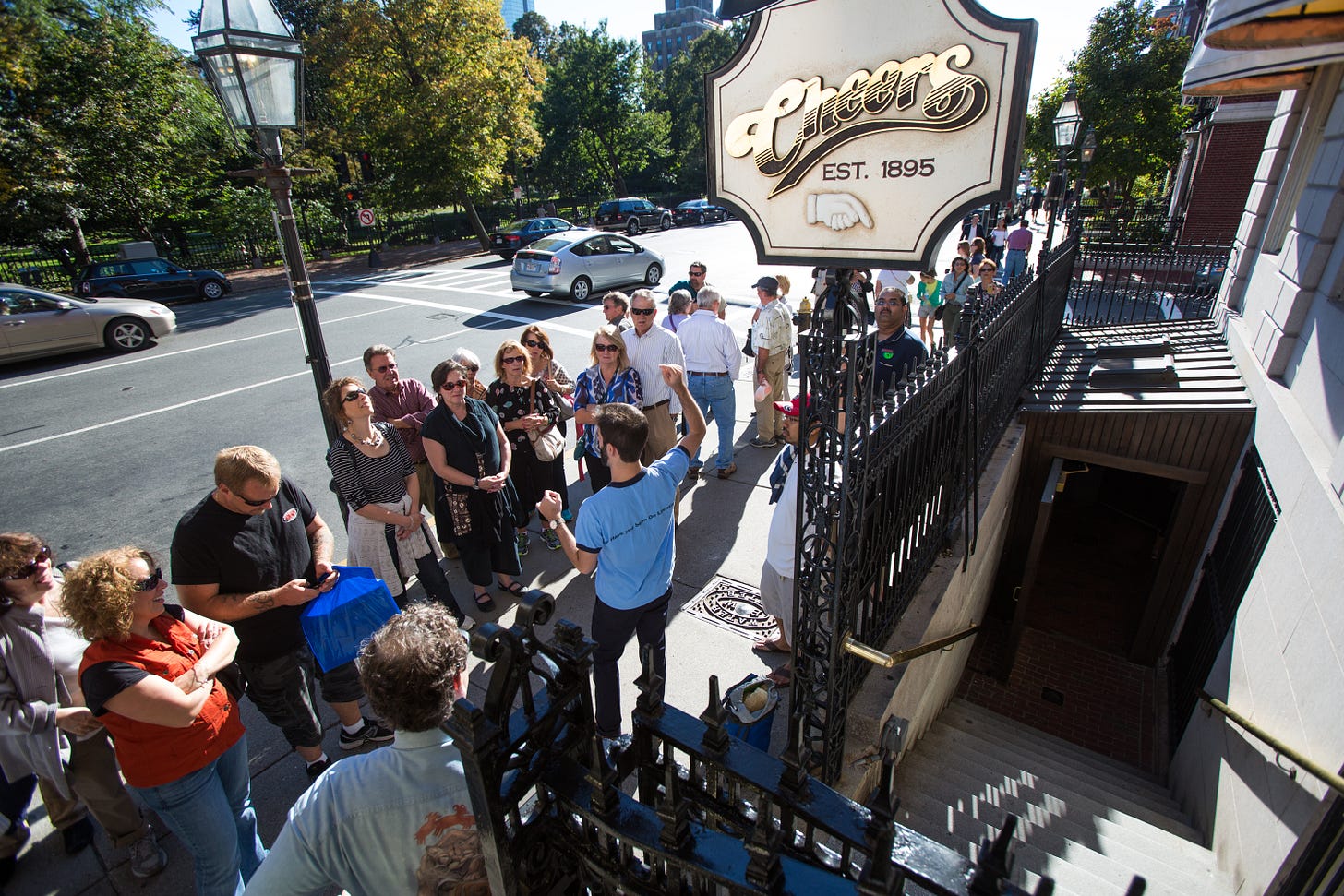
After seeing the popularity of the TV series Cheers, it didn’t take long for The Bull and Finch Pub, the Boston bar that was used for exterior shots, to be converted from a local watering hole to a TGI Friday’s-esque bar named (what else?) Cheers, with a gift shop that sells Cheers souvenirs and sort of resembles the famous bar inside.
Tourists still flock to Cheers, despite the fact that the show ended almost 30 years ago. I bet most of the people visiting these days associate Ted Danson more with Kristen Bell than with Kirstie Alley, yet when you say you’re visiting Boston, Cheers is still a must see destination for some odd reason.
These are extreme examples of preservation and capitalization, but if the travel habits of myself and the folks from Twitter are any indication, they may be worthwhile endeavors. The people will come either way- why not sell them a T-shirt while you’re at it?
Even larger in scale was HGTV’s renovation of The Brady Bunch house. Like the Christmas Story house, the interior sets bore no resemblance to the actual house which was used for exterior shots. When the family that had owned the house since the Brady era finally decided to sell, HGTV swooped in.
What followed was an all-star renovation featuring nearly every star in the HGTV universe working alongside the Brady children to faithfully recreate the sets from the show within the shell of the original house. (I talked to Maureen McCormick about this last year).
The project involved digging out the original floor several feet to accommodate a two-story stair hall under a single-story roof, adding on a massive addition, and even installing Astroturf in the backyard to make it match the set. The finished product garnered HGTV an Emmy nomination, loads of good press, and a setting for many subsequent HGTV and Discovery+ shoots. Unlike others on the list, however, The Brady Bunch house is not open to the public.
Can I Borrow $3.9 Million?
Jean Yoon, one of the stars of the groundbreaking (but now defunct) Canadian comedy series Kim’s Convenience posted this Toronto Star article along with her commentary last week:

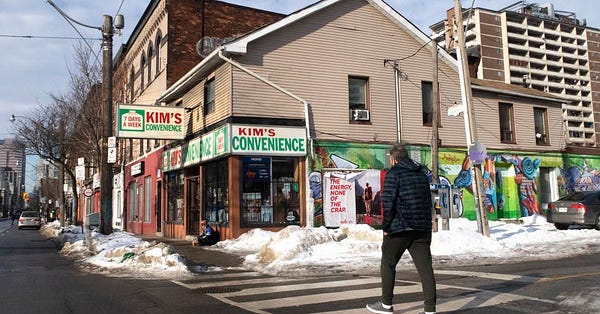
If you have not yet had the pleasure of discovering Kim’s Convenience, I am a HUGE fan! The show ran for five seasons in Canada, but it became an international phenomenon when it began streaming on Netflix in 2018. I discovered and fell in love with it during the pandemic and even spoke with star Paul Sun-Hyung Lee.
While most of the series was shot on a soundstage, there was (and still is) an actual convenience store in the Moss Park neighborhood in Downtown Toronto that was used for exterior shots. Not unlike Cheers, the store was called Mimi Variety for about 30 years of its existence, until the production team added the Kim’s Convenience signage for the show. The store kept the signs long after the shoot and even officially rebranded to Kim’s Convenience (it’s not like people were booking vacations to visit Mimi Variety). It has become quite the tourist destination, not only for fans of the show, but even the stars, who post to Instagram anytime they stop by.
Upon hearing that the store was for sale, (albeit for $3.9 million Canadian), my first impulse was “I have to buy that!” Not that I have $3.9 million (or even $.9 million) lying around.
And what would my options be were I to purchase it? Move to Canada to operate a convenience store? Convert it into some kind of museum to the series? Why was I even considering this??
I think a big part of it was that simple light box sign with its bold letters brought me so much joy over the pandemic and I was sad to imagine that it might be in a dumpster on my next trip to Toronto, the building it was once attached to demolished in favor of higher density apartment buildings.
Which is perhaps what keeps us coming back to these locations. Movies, and to some extent TV shows, have a certain permanence to them, in a way that little else in our world does.
My kids still watch The Wizard of Oz, and it’s WAY older than their grandparents. Judy Garland died 15 years before I was even born. The songs and drama endure, while only a ratty pair of the Ruby Slippers survives, encased in glass at the Smithsonian. I will never walk the actual Yellow Brick Road, but I can always visit it on my TV by just asking Siri to play the movie.
So why do we choose to make filming locations destinations when we travel? Perhaps it’s the understanding that they won’t always be there. While reruns of The Brady Bunch or Cheers aren’t going anywhere, their real world counterparts might someday. We’re one earthquake, one fire, one real estate deal to a non-sentimental developer away from letting a beloved place slip into the abyss or become altered in a way that it no longer matches what we remember.
Of course, the needs of each era dictate how something is to be used, if it is to be saved, or if it should be discarded and made into something else. 75 years ago, a house like the one from A Christmas Story in Cleveland was likely owned by a worker at one of the steel mills that belted flame and ash across much of the inner city. Today, as the population of the region has shrunk and industry has largely moved overseas, that house is more useful (or at least more profitable) as a nostalgia repository. Would that calculation have made as much sense if A Christmas Story wasn’t in constant repeat on cable for the last four decades? Probably not.
Perhaps we visit these places to feel a deeper connection to a story we love or stars that we admire. Maybe it’s just to say that we visited, not unlike the desire to stop at a quirky place like the World’s Largest Dreamcatcher on a road trip (it’s in Arizona, and yes, we’ve stopped there too). In the era of social media, clout and bragging rights bring a different perspective to all of this too.
Whatever the reason, it seems inevitable that the choices a location scout and director make on a particular project may have lasting reverberations for the property owners and neighbors of that site, long after the grip trucks and camera cranes have been wrapped from production. If you ever get an offer to have a crew film at your house, just remember that you may be making a very, very long term commitment.
Please consider sharing this with a friend that you think might enjoy reading this, or better yet, share it on social media so you can tell hundreds of friends!
If you have questions, comments, thoughts, ideas, or anything else that you’d like to share, please feel free to email me anytime.
If you’d like to catch up on past episodes of the Quarantine Creatives podcast, they can be found on Apple Podcasts, Spotify, or wherever you listen.
If you’ve missed past issues of this newsletter, they are available to read here.
Stay Safe!
Heath





